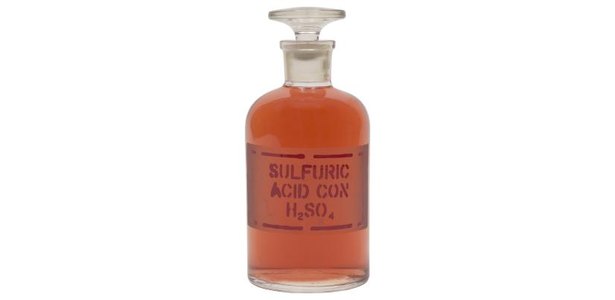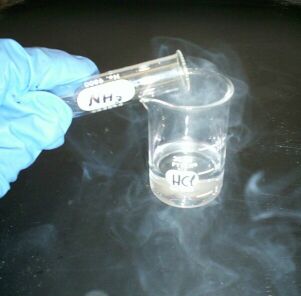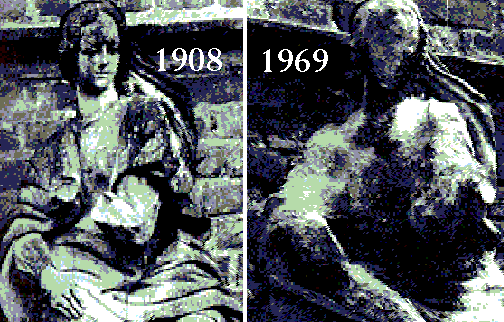Example of acidic products:
| Citric acid in lemon can conduct electricity |
| Carbonated drinks (carbonic acid) |
| Acetic/ethanoic acid in vinegar |
| Tomato ketchup |
 |
| Sulfuric acid, a strong acid |
 |
| Hydrochloric acid found in stomach digestive juices |
Testing with Litmus Paper
| Acid turn blue litmus to red |
Testing with Universal indicator
To find the out how acidic a substance is, one or two drops of universal indicator is mixed into the substance.
| Universal indicator solution |
| Universal indicator paper/ pH paper |
The colour change is matched to a pH scale ranged from 0 to 14 as below. A substance with a pH of less than 7 is an acid. The lower the pH(below 7), the more acidic the substance. One with a pH of 7 is neutral. One with a pH of greater than 7 is an alkaline, the higher the pH(above 7), the more alkaline a substance.
| Acids | Molecules Formula | Strong/Weak Acid | pH |
|---|---|---|---|
| Hydrochloric acid | HCl (aq) | Strong acid | 0 to 1 |
| Sulfuric acid | H2SO4 (aq) | Strong acid | 1 to 2 |
| Nitric acid | HNO3 (aq) | Strong acid | 1 to 2 |
| Acetic/Ethanoic acid (vinegar acid) | CH3COOH (aq) | Weak acid | 3 to 5 |
| Citric acid (lemon/lime juice) | C6H8O7 | Weak acid | 2.5-6.0 |
| Carbonic acid (fizzy drink) | H2CO3 (aq) | Weak acid | 2.4 |
| Methanoic acid/ Formic Acid (ant stings) | HCOOH /HCO2H | Weak acid | 3.7 |
| Sulfurous acid (acid rain) | H2SO3 (aq) | Weak acid | varied |
| Ascorbic acid (vitamin C) | C6H8O6 | Weak acid | 4.1 |
Properties of Acids
- taste sour
- soluble in water
- corrosive
- conduct electricity
- react with certain metals and give out hydrogen gas
- react with metal carbonates and give out carbon dioxide gas
- react with bases to form salts and water
| A victim of acid attack |
 |
| Sulfurous acid(acid rain) a weak acid, when oxidised to sulfuric acid it becomes strong acid and damages the environment quite badly. |
Hydrogen ions is responsible for the 'acidic' condition
In order to show acidity, the substance must be dissolved in water. For an example, gaseous hydrogen chloride, HCl(g), is not acidity but when it dissolves in water an acidic solution is produced.
Strong Acid or Weak Acid
Solubility of the H+ ions in water indicates the strength of the acid. Strong acid means the acid can easily dissociates(ionises) to produce hydrogen ions in water.It is important to note that a concentrated acid does not mean it is a strong acid and a dilute acid does not mean it is a weak acid. Concentration of an acid only indicate the proportions of water and acid present in aqueous solution. For examples hydrochloric acid is a strong acid, virtually 100% hydrogen ionised; even a diluted hydrochloric acid is still a strong acid. For the same reason, ethanoic acid found in the vinegar is a weak acid, only partial hydrogen ionised; concentrated ethonoic acid is still a weak acid.
An acid is strong acid if all of its H+ ions dissociates(ionises) to form hydrogen ions in the water. An acid is weak acid if only small amount of its H+ ions dissociates(ionises) to form hydrogen ions in the water.
Hydrochloric acid is a strong acid because all the hydrogen chloride molecules break up to form H+ ions and Cl- ions.
water
hydrogen chloride -------------> hydrogen ions + chloride ions
water
HCl (g) -------------> H+ (aq) + Cl- (aq)

Ethanoic acid (vinegar) is a weak acid because it produces few hydrogen ions when dissolves in water. Only partial of the hydrogens in ethanoic acid dissociate to form hydrogen ions in the water. the hydrogen ions and ethonate ions dissociated will react together to re-form the ethanoic acid molecule again since it is a reversible reaction.
ethanoic acid
 hydrogen ions + ethanoate ions
hydrogen ions + ethanoate ionswater
CH3COOH(aq)
 H+ (aq) + CH3COO- (aq)
H+ (aq) + CH3COO- (aq)